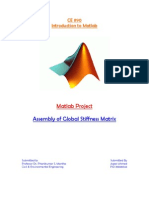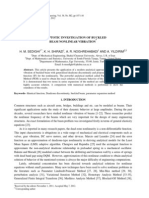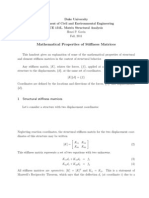Truss Mathematics
Truss Mathematics
Uploaded by
Oladunni AfolabiCopyright:
Available Formats
Truss Mathematics
Truss Mathematics
Uploaded by
Oladunni AfolabiOriginal Description:
Original Title
Copyright
Available Formats
Share this document
Did you find this document useful?
Is this content inappropriate?
Copyright:
Available Formats
Truss Mathematics
Truss Mathematics
Uploaded by
Oladunni AfolabiCopyright:
Available Formats
THE DIRECT STIFFNESS METHOD FOR PLANAR TRUSSES CE 131L. Matrix Structural Analysis Henri P.
Gavin Fall, 2009
Method
1. Number all of the joints and all of the elements. 2. Identify the Structural Degrees of Freedom in Global Directions. Number all the structural degrees of freedom in your truss. In a planar truss, each joint can have a maximum of two degrees of freedom: one in the global X -direction and one in the global Y -direction. If a degree of freedom is restrained by a reaction, then it doesnt get a number. 3. Joint Locations. Write the (x, y ) coordinates of each joint using units consistent with E and A. In other words, if E and A are given in kN/cm2 and cm2 , write the (x, y ) coordinates in terms of centimeters. 4. Dene each element. Draw each element of your truss individually and draw the local coordinates in the global directions. For example if element number N is a diagonal truss element, and the global directions are X: horizontal and Y: vertical, draw element number N like this:
4 Bar Direction 2
2
3
(x , y )
2
1 1
Local Joint Number Element Coordinate in Global Directions
2 1
(x , y )
1 1
where 1,2,3,4 are the element coordinates of the truss bar in the global directions. The local coordinates are always numbered 1,2,3,4 with 1 and 3 pointing in the global X direction (to the right) and with 2 and 4 pointing in the global Y direction (up). Some or all of these four coordinates will line up with with the structural degrees of freedom that you identied in step 2., above. The angle is the counter-clockwise angle from element coordinate 1 to the truss bar.
CE 131L. Matrix Structural Analysis Duke University Fall 2009 H.P. Gavin
5. Element Stiness Matrices in Global Coordinates, K. For each element, nd its (4x4) element stiness matrix, by evaluating the equations below: L = (x2 x1 )2 + (y2 y1 )2 c = (x2 x1 )/L s = (y2 y1 )/L EA K= L
c2 cs c2 cs cs s2 cs s2 . c2 cs c2 cs 2 2 cs s cs s
or by using the TRUSS script in matlab. You should understand where these equations come from, why this matrix is symmetric, why the diagonal terms are all positive, and what the o-diagonal terms mean. 6. Structural Stiness Matrix, Ks . The structural stiness matrix is a square, symmetric matrix with dimension equal to the number of degrees of freedom. In this step we will ll up the structural stiness matrix using terms from the element stiness matrices in global coordinates (from step 5.) This procedure is called matrix assembly. Recall from step 4. how the element degrees of freedom (1,2,3,4) line up with the structural degrees of freedom in your problem. For example, coordinates (1,2,3,4) might line up with degrees of freedom (3,4,7,8) of the truss. In this case, to assemble this element into the structural stiness matrix,
K(1,1) +> Ks(3,3) | K(1,2) +> Ks(3,4) | K(1,3) +> Ks(3,7) | K(1,4) +> Ks(3,8) ------------------|-------------------|-------------------|-----------------K(2,1) +> Ks(4,3) | K(2,2) +> Ks(4,4) | K(2,3) +> Ks(4,7) | K(2,4) +> Ks(4,8) ------------------|-------------------|-------------------|-----------------K(3,1) +> Ks(7,3) | K(3,2) +> Ks(7,4) | K(3,3) +> Ks(7,7) | K(3,4) +> Ks(7,8) ------------------|-------------------|-------------------|-----------------K(4,1) +> Ks(8,3) | K(4,2) +> Ks(8,4) | K(4,3) +> Ks(8,7) | K(4,4) +> Ks(8,8)
where the +> is short-hand for is added to .... K(1,3) is added to Ks(3,7). Add each element into the structural stiness matrix in this way to get Ks . Note that if one end of the truss element is fully restrained in both the the X - and Y - directions, you will need to place only four of the sixteen terms of the elements 4x4 stiness matrix. 7. Forces, p. Create the force vector p, by nding the components of each applied force in the directions of the global degrees of freedom. Create the force vector by placing these force components into the force vector at the proper coordinates.
Stiness Method for Planar Trusses
8. Deections, d. Find the deections by inverting the stiness matrix and multiplying it by the load vector. You can do this easily in matlab: d = Ks \ p 9. Internal bar forces, n. Again, recall how the global degrees of freedom line up with each elements coordinates (1,2,3,4). For example, in element number N from step 6., the local element deections in the global directions, v1 , v2 , v3 , v4 line up with the structural deections deections d3 , d4 , d7 , d8 . The internal bar forces can be computed from: EA EA [c(v3 v1 ) + s(v4 v2 )] = [c(d7 d3 ) + s(d8 d4 )] n= L L where c and s are the direction cosine and sine for the element from step 5. You should be able to derive this equation. Knowing what each bar force is, the reactions can be easily computed with equilibrium equations. Notation u q k T v f K d p Ks = = = = = = = = = = Element deection vector in the Local coordinate system Element force vector in the Local coordinate system Element stiness matrix in the Local coordinate system ... q = k u Coordinate Transformation Matrix (orthonormal) ... T1 = TT Element deection vector in the Global coordinate system ... u = T v Element force vector in the Global coordinate system ... q = T f Element stiness matrix in the Global coordinate system ... K = TT k T Structural deection vector in the Global coordinate system Structural load vector in the Global coordinate system Structural stiness matrix in the Global coordinate system ... p = Ks d Coordinate System Element Deection Element Force Element Stiness Structural Deection Structural Loads Structural Stiness Local Global u q k v f K d p Ks
CE 131L. Matrix Structural Analysis Duke University Fall 2009 H.P. Gavin
Example
Y
4 E = 30,000 k/sq.in. A = 10 sq.in. 12 ft. 3 3 6 4 5 6 50 k 5
1 1 2 2
3 2 7 1 100 k
5 4
16 ft. 1 2 Global Joint Number Bar Number Bar Direction 1 1 1 Structural Degree of Freedom Applied Force Local Joint Number
16 ft.
System Equation: {f} = [K}{d} {d} : displacement vector = { d1 d2 d3 d4 d5 d6 } {f} : load vector = { 0 100 0 0 50 0 } 4 2 3
Local Degree of Freedom Global Coordinate System 1 2 1
Element Coordinates in Global Directions
Stiness Method for Planar Trusses
function K = truss( x1,y1,x2,y2,E,A ) % K = TRUSS (X1,Y1,X2,Y2,E,A) % Returns a 2-D truss element stiffness matrix in global coordinates % % X1,Y1 are the coordiniates of joint 1 of the truss element % X2,Y2 are the coordiniates of joint 2 of the truss element % E is the elastic modulus % A is the cross sectional area L = sqrt( (x2-x1)^2 + (y2-y1)^2 ); c = (x2-x1) / L; s = (y2-y1) / L; K = (E*A/L) * [ c^2 c*s -c^2 -c*s c*s s^2 -c*s -s^2 -c^2 -c*s c^2 c*s -c*s -s^2 c*s s^2 ; ; ; ];
% --------------------------------------------------------- TRUSS hudson17% matlab >> help truss K = TRUSS (X1,Y1,X2,Y2,E,A) Returns a 2-D truss element stiffness matrix in global coordinates X1,Y1 are the coordiniates of joint 1 of the truss element X2,Y2 are the coordiniates of joint 2 of the truss element E is the elastic modulus A is the cross sectional area >> format bank >> E = 3e4; >> A = 10; % two decimal places after the . % modulus of elasticity % area of cross section
>> K1 = truss(0,0,12*16,12*12,E,A) K1 = 800.00 600.00 -800.00 -600.00 600.00 450.00 -600.00 -450.00 -800.00 -600.00 800.00 600.00 -600.00 -450.00 600.00 450.00
% member 1
CE 131L. Matrix Structural Analysis Duke University Fall 2009 H.P. Gavin
>> K2 = truss(0,0,12*16,0,E,A) K2 = 1562.50 0.00 -1562.50 0.00 0.00 0.00 0.00 0.00 -1562.50 0.00 1562.50 0.00 0.00 0.00 0.00 0.00
% member 2
>> K3 = truss(12*16,0,12*16,12*12,E,A) K3 = 0.00 0.00 0.00 0.00 0.00 2083.33 0.00 -2083.33 0.00 0.00 0.00 0.00 0.00 -2083.33 0.00 2083.33
% member 3
>> K4 = truss(12*16,12*12,12*32,12*12,E,A) K4 = 1562.50 0.00 -1562.50 0.00 0.00 0.00 0.00 0.00 -1562.50 0.00 1562.50 0.00 0.00 0.00 0.00 0.00
% member 4
>> K5 = truss(12*16,12*12,12*32,0,E,A) K5 = 800.00 -600.00 -800.00 600.00 -600.00 450.00 600.00 -450.00 -800.00 600.00 800.00 -600.00 600.00 -450.00 -600.00 450.00
% member 5
>> K6 = truss(12*16,0,12*32,12*12,E,A) K6 = 800.00 600.00 -800.00 -600.00 600.00 450.00 -600.00 -450.00 -800.00 -600.00 800.00 600.00 -600.00 -450.00 600.00 450.00
% member 6
Stiness Method for Planar Trusses
7
% member 7
>> K7 = truss(12*16,0,12*32,0,E,A) K7 = 1562.50 0.00 -1562.50 0.00 0.00 0.00 0.00 0.00 -1562.50 0.00 1562.50 0.00 0.00 0.00 0.00 0.00
>> K8 = truss(12*32,0,12*32,12*12,E,A) K8 = 0.00 0.00 0.00 0.00 0.00 2083.33 0.00 -2083.33 0.00 0.00 0.00 0.00 0.00 -2083.33 0.00 2083.33
% member 8
% ----------------------------
input the Global Stiffness Matrix by hand ...
>> Ks = [ 3925 600 0 0 -800 -600 > 600 2533.33 0 -2083.33 -600 -450 > 0 0 3162.5 0 -1562.5 0 > 0 -2083.33 0 2983.33 0 0 > -800 -600 -1562.5 0 2362.5 600 > -600 -450 0 0 600 2533.33
; ; ; ; ; ]
Ks = 3925.00 600.00 0.00 0.00 -800.00 -600.00
600.00 2533.33 0.00 -2083.33 -600.00 -450.00
0.00 0.00 3162.50 0.00 -1562.50 0.00
0.00 -2083.33 0.00 2983.33 0.00 0.00
-800.00 -600.00 -1562.50 0.00 2362.50 600.00
-600.00 -450.00 0.00 0.00 600.00 2533.33
CE 131L. Matrix Structural Analysis Duke University Fall 2009 H.P. Gavin
>> find(Ks-Ks) ans = [](0x0)
% check to see if Ks is symmetric ... % It is!
>> p = [ 0 -100 0 0 50 0 ] p = 0.00 -100.00 0.00 0.00 50.00 0.00 >> format
% input the load vector
% change formats for more sig. figs
>> d = Ks \ p d = 0.0146067 -0.1046405 0.0027214 -0.0730729 0.0055080 -0.0164325
% compute the joint displacements
You might also like
- JD Jackson Solution Chapter 1 and 2Document56 pagesJD Jackson Solution Chapter 1 and 2JYOTIPRASAD DEKA100% (1)
- Attachment Iv - Nigeria Content Execution Plan PDFDocument4 pagesAttachment Iv - Nigeria Content Execution Plan PDFOladunni Afolabi100% (4)
- ENSC3001 - Exam NotesDocument13 pagesENSC3001 - Exam NotesGeoffreyWanNo ratings yet
- MATLAB Project Assembling The Global Stiffness MatrixDocument16 pagesMATLAB Project Assembling The Global Stiffness MatrixSuneel Kanhar100% (2)
- Truss MethodDocument9 pagesTruss Methodfanion47No ratings yet
- Truss Matlab Mef StifnessDocument8 pagesTruss Matlab Mef StifnessAoun Omar100% (1)
- Mechanics of Solids Week 10 LecturesDocument9 pagesMechanics of Solids Week 10 LecturesFlynn GouldNo ratings yet
- FEM Exam With SolutionDocument8 pagesFEM Exam With SolutionArifian Agusta100% (3)
- Analysis of Frames Beams TrussesDocument17 pagesAnalysis of Frames Beams TrussesRameez AnwarNo ratings yet
- 4500ICBTEGDocument9 pages4500ICBTEGKalana wickramanayakaNo ratings yet
- 4 Node QuadDocument27 pages4 Node QuadMathiew EstephoNo ratings yet
- 3d TrussDocument5 pages3d Trussganesh_withucadNo ratings yet
- Finite Element Method Chapter 4 - The DSMDocument17 pagesFinite Element Method Chapter 4 - The DSMsteven_gogNo ratings yet
- Beam Element in FEM/FEADocument24 pagesBeam Element in FEM/FEAOnkar KakadNo ratings yet
- 10-Linear Strain Triangle and Other Types of 2d ElementsDocument31 pages10-Linear Strain Triangle and Other Types of 2d Elementskranthi142434No ratings yet
- Paper 23-A New Type Method For The Structured Variational Inequalities ProblemDocument4 pagesPaper 23-A New Type Method For The Structured Variational Inequalities ProblemEditor IJACSANo ratings yet
- Higher Order Elements: Steps in The Formulation of LST Element Stiffness EquationsDocument7 pagesHigher Order Elements: Steps in The Formulation of LST Element Stiffness EquationsChatchai ManathamsombatNo ratings yet
- 3D Truss AnalysisDocument5 pages3D Truss AnalysisMarco DanielNo ratings yet
- Performance of The Finite Strip Method For Structural Analysis On A Parallel ComputerDocument14 pagesPerformance of The Finite Strip Method For Structural Analysis On A Parallel ComputerFabio OkamotoNo ratings yet
- C 3 C V, V C 3.1 C: Hapter Ontrol Olumes Ector AlculusDocument10 pagesC 3 C V, V C 3.1 C: Hapter Ontrol Olumes Ector Alculusnanduslns07No ratings yet
- Tutorial 1Document2 pagesTutorial 1facts scientiaNo ratings yet
- Determinants: Ms Do Thi Phuong Thao Fall 2012Document31 pagesDeterminants: Ms Do Thi Phuong Thao Fall 2012minhthang_hanuNo ratings yet
- Analysis of A Rectangular Waveguide Using Finite Element MethodDocument9 pagesAnalysis of A Rectangular Waveguide Using Finite Element MethodV'nod Rathode BNo ratings yet
- MANE 4240 & CIVL 4240 Introduction To Finite Elements: Prof. Suvranu deDocument40 pagesMANE 4240 & CIVL 4240 Introduction To Finite Elements: Prof. Suvranu devenky364No ratings yet
- FRAMEDocument209 pagesFRAMELeeCH LeeCHNo ratings yet
- 4curve Fitting TechniquesDocument32 pages4curve Fitting TechniquesSubhankarGangulyNo ratings yet
- Buckled Beam Nonlinear VibrationDocument10 pagesBuckled Beam Nonlinear Vibrationhmsedighi459No ratings yet
- A06 Plate Bending Element With FontsDocument6 pagesA06 Plate Bending Element With FontsSeyhan ÖzenNo ratings yet
- Basu-Fem Notes Me623Document210 pagesBasu-Fem Notes Me623Subhradeep ChatterjeeNo ratings yet
- Hmwk01 APAM4300Document14 pagesHmwk01 APAM4300Renzo Alexander Montoya MoralesNo ratings yet
- Lecture 2: Review of Vector Calculus: Instructor: Dr. Gleb V. Tcheslavski Contact: Office Hours: Class Web SiteDocument30 pagesLecture 2: Review of Vector Calculus: Instructor: Dr. Gleb V. Tcheslavski Contact: Office Hours: Class Web Siterkumar_504291No ratings yet
- Pre PrintDocument30 pagesPre Printgorot1No ratings yet
- Modeling and Mathematical Formulation: 4-1: Finite Element FormulationsDocument24 pagesModeling and Mathematical Formulation: 4-1: Finite Element FormulationsHusseinali HusseinNo ratings yet
- Pdf&rendition 1Document6 pagesPdf&rendition 1Priyanka ChauhanNo ratings yet
- PEME200001 Mathematical Techniques 2Document10 pagesPEME200001 Mathematical Techniques 2Andrew AndersonNo ratings yet
- Sankar Shil PDFDocument17 pagesSankar Shil PDFChandra Kishore PaulNo ratings yet
- NP Tel ProblemsDocument18 pagesNP Tel ProblemsSreedevi KrishnakumarNo ratings yet
- Chapter 16Document43 pagesChapter 16German ToledoNo ratings yet
- Se130b HW2Document6 pagesSe130b HW2Yannis KoutromanosNo ratings yet
- Appendix 10 PDFDocument10 pagesAppendix 10 PDFHusseinali HusseinNo ratings yet
- Finite Element Analysis by S.S. Bhavikatti, New Age Int. (2005)Document11 pagesFinite Element Analysis by S.S. Bhavikatti, New Age Int. (2005)Ravi Pratap SinghNo ratings yet
- Eigen Value-Stifness MatrixDocument9 pagesEigen Value-Stifness Matrixumuduma85No ratings yet
- Integration On QuadrilateralsDocument12 pagesIntegration On QuadrilateralsjygeorgeNo ratings yet
- Tutorial 5Document4 pagesTutorial 5NUR ADRIANA FARIESYA BINTI MOHD RIZAIMINo ratings yet
- Shape FunctDocument46 pagesShape FunctKashmir Jamadar100% (1)
- Symmetry and Bandwidth: AE and Bars 3, 4, 5, and 6Document11 pagesSymmetry and Bandwidth: AE and Bars 3, 4, 5, and 6Hilary WatsonNo ratings yet
- Jacobi EDODocument10 pagesJacobi EDOJhon Edison Bravo BuitragoNo ratings yet
- FEM BasicDocument70 pagesFEM Basicformech100% (1)
- Some Modified Matrix Eigenvalue: E 2 (X), (A I) A (X) - (9) ) - A (A) O'i (A O'2 (A A, (A) 21 (A) 22 (A) 2, (A)Document17 pagesSome Modified Matrix Eigenvalue: E 2 (X), (A I) A (X) - (9) ) - A (A) O'i (A O'2 (A A, (A) 21 (A) 22 (A) 2, (A)Satyavir YadavNo ratings yet
- Free Vibration of Laminated Plates by A Variable-Kinematic Chebyshev-Ritz MethodDocument3 pagesFree Vibration of Laminated Plates by A Variable-Kinematic Chebyshev-Ritz MethoddozioNo ratings yet
- SLAM of Multi-Robot System Considering Its Network Topology: H. W. Dong, Z. W. LuoDocument2 pagesSLAM of Multi-Robot System Considering Its Network Topology: H. W. Dong, Z. W. LuopaperopenaccessNo ratings yet
- LogitDocument8 pagesLogitRobson GlasscockNo ratings yet
- Student Solutions Manual to Accompany Economic Dynamics in Discrete Time, second editionFrom EverandStudent Solutions Manual to Accompany Economic Dynamics in Discrete Time, second editionRating: 4.5 out of 5 stars4.5/5 (2)
- Logical progression of twelve double binary tables of physical-mathematical elements correlated with scientific-philosophical as well as metaphysical key concepts evidencing the dually four-dimensional basic structure of the universeFrom EverandLogical progression of twelve double binary tables of physical-mathematical elements correlated with scientific-philosophical as well as metaphysical key concepts evidencing the dually four-dimensional basic structure of the universeNo ratings yet
- Robot Manipulators: Modeling, Performance Analysis and ControlFrom EverandRobot Manipulators: Modeling, Performance Analysis and ControlNo ratings yet
- Log-Linear Models, Extensions, and ApplicationsFrom EverandLog-Linear Models, Extensions, and ApplicationsAleksandr AravkinNo ratings yet
- QMS MANUAL - QMS MNL 51 001 - R0 - ApprovedDocument52 pagesQMS MANUAL - QMS MNL 51 001 - R0 - ApprovedOladunni Afolabi100% (4)
- The Role of Transaction Advisers in A PPP Project PDFDocument15 pagesThe Role of Transaction Advisers in A PPP Project PDFOladunni AfolabiNo ratings yet
- The Role of Transaction Advisers in A PPP Project PDFDocument15 pagesThe Role of Transaction Advisers in A PPP Project PDFOladunni AfolabiNo ratings yet
- Kogi Water Layout New PDFDocument1 pageKogi Water Layout New PDFOladunni AfolabiNo ratings yet
- Wire Size and Amp Ratings PDFDocument3 pagesWire Size and Amp Ratings PDFOladunni AfolabiNo ratings yet
- Audit Report 2013-11 - Public Works - Construction Contracts Review (AUD14003) (City Wide)Document7 pagesAudit Report 2013-11 - Public Works - Construction Contracts Review (AUD14003) (City Wide)Oladunni AfolabiNo ratings yet
- Attachment IV - Nigeria Content Execution PlanDocument4 pagesAttachment IV - Nigeria Content Execution PlanOladunni AfolabiNo ratings yet
- Fighting Sexual TemptationsDocument27 pagesFighting Sexual TemptationsOladunni Afolabi100% (1)
- Admin Block ElevationDocument1 pageAdmin Block ElevationOladunni AfolabiNo ratings yet
- Structural Steelwork For Reinforced Concrete Structural Steelwork For Steel Trusses General Notes Concrete BlockworkDocument1 pageStructural Steelwork For Reinforced Concrete Structural Steelwork For Steel Trusses General Notes Concrete BlockworkOladunni AfolabiNo ratings yet
- Admin Block-Floors PlansDocument1 pageAdmin Block-Floors PlansOladunni AfolabiNo ratings yet
- Culvet KM 0+250 Wingwall Project Lay OutDocument1 pageCulvet KM 0+250 Wingwall Project Lay OutOladunni AfolabiNo ratings yet
- Sector Insights: Skills and Performance Challenges in The Energy SectorDocument13 pagesSector Insights: Skills and Performance Challenges in The Energy SectorOladunni AfolabiNo ratings yet
- 1.1.16 Socioeconomic Traffic Lagos PDFDocument15 pages1.1.16 Socioeconomic Traffic Lagos PDFOladunni AfolabiNo ratings yet
- Conceptual Design of A Wastewater Treatment Plant of CotorroDocument8 pagesConceptual Design of A Wastewater Treatment Plant of CotorroAndresNo ratings yet
- 2010 Highway Construction PDFDocument646 pages2010 Highway Construction PDFOladunni AfolabiNo ratings yet
- Methods of Concrete Column Repair For Cracks and Damages PDFDocument3 pagesMethods of Concrete Column Repair For Cracks and Damages PDFOladunni Afolabi100% (2)
- Auxilliary Lane DesignDocument21 pagesAuxilliary Lane DesignOladunni AfolabiNo ratings yet













































































